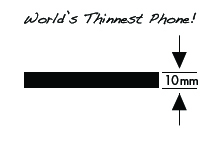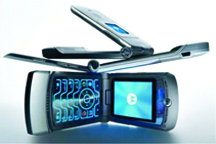Design That Moves Business: The Motorola RAZR Effect (Part 2)
By guest authors Charles W. Bush and Kathy Hwang of 3Strand Innovation, a brand, design and business consultancy
While any company should be proud of a market success like the RAZR mobile phone, Motorola’s story is even more remarkable because it came out of an older corporation that was able to adapt for innovation. The original vision for the RAZR found its roots in a dream in 2003. We break down some of the elements of the company’s approach below.

START IDEAS AT THE LOCAL PUB
Like many great stories, this one starts over beers at a local pub where Roger Jellicoe, a senior engineer, convinced Rob Shaddock, a wireless executive, to give him the reigns to do the impossible.

SET AN “IMPOSSIBLE” GOAL
Their impossible goal was to make the world’s thinnest mobile phone, at 10 millimeters thick. Shaddock and Jellicoe knew that innovation meant risk. If they wanted a “safe” product, chances were that they were going to get something that looked like Motorola’s last success. Instead, this project stressed design from day one. They knew that the engineering had be turned upside down and completely redesigned if they were going to meet their design goals. Surprisingly, Motorola never intended the phone to be a big seller. It was only meant to bring visibility and awareness back to the company. They planned to debut it at the 2004 Oscars.

HOLD OFF THE PEANUT GALLERY
Jellicoe knew that if they were going to something different, they needed to get away from Motorola. “Anytime you’ve got something radically different, there will be people who feel that we should be putting our resources on other stuff,” he said during a 2006 interview. Jellicoe was able to leverage the project to recruit the top talent in the otherwise “safe” company. Based on the drive for something new and exciting, Shaddock had enough faith to give Jellicoe’s team time and privacy to get to work.

DE-SILO PROFESSIONS
The part we found most interesting is that even though the phone was just supposed to be an Oscars-worthy trinket, the team’s united dedication to form and function was what led to its perfection. Design stylists were brought into the secret enclave and worked side by side with engineers. This helped them balance engineering requirements with the visual branding. The look and feel they were aiming for was “rich minimalism”.

KEEP NO SACRED COWS
The result is what makes the RAZR so special. The cell phones on the market at the time were either (1) fashionable, but large with confusing functions, or (2) simple, cheap and generic. Going back and forth between functional requirements and visual ideals forced the team to question assumptions and find more simple solutions. Features were thrown out, engineering was rethought, and even Motorola’s own ergonomic standards were thrown out the window. In the end the team ended up striking a balance with the coolest looking, thinnest phone.

HOLD FIRMLY TO THE DESIGN INTENT
By the time the Oscars were approaching, the Motorola team found themselves facing some serious problems. They weren’t going to be able to make the deadline for their Oscar debut if they stuck to the original design intent. They still hadn’t perfected the materials or resolved how to create the appearance of the cool-blue “night signature” of the keypad. Now this is the point where many companies choose to take the route of the death-by-a-thousand-cuts and put out an inferior product on time. The team made the gutsy decision to push back the deadline and miss the Oscars to make sure they came out with a superior product.
Looking back, it’s interesting to note that something as seemingly inconsequential as the cool-blue keypad glow was enough to push us over the edge to purchase our own RAZRs.
This segment is part 2 in the series : Design That Moves Business: The Motorola RAZR Effect
1 2
Featured Videos
Can 1M/1M Help Me Raise Money?
How Does 1M/1M Democratize Entrepreneurship Education?
How Does 1M/1M Democratize Management Consulting?
When Is The Right Time To Join 1M/1M?
Can 1M/1M Help Me With Business Development?
Can 1M/1M Help Me With Market Sizing?
Can 1M/1M Help Me Validate My Product?
Will I Have Private 1-on-1 Sessions In 1M/1M?
How Does 1M/1M Help Entrepreneurs Connect With Silicon Valley?
Mentoring or Consulting?
Why Does 1M/1M Charge $1000 a Year?
Why Does 1M/1M Partner With Local Organizations?
Why Don\’t Mentoring Networks Work?
Why Is It Important To Study With 1M/1M Now?
Dan Stewart Story
Vikrant Mathur Story
